They say it’s a man’s world. But in the typical American family, it’s the woman who wears the pantsuit.
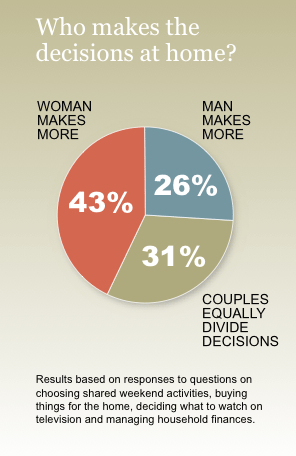
To explore decision-making in the typical American home, a Pew Research Center survey asked men and women living in couples which one generally makes the decisions in four familiar areas of domestic life. Who decides what you do together on the weekend? Who manages the household finances? Who makes the decisions on big purchases for the home? And who most often decides what to watch on television?
The survey finds that in 43% of all couples it’s the woman who makes decisions in more areas than the man. By contrast, men make more of the decisions in only about a quarter (26%) of all couples. And about three-in-ten couples (31%) split decision-making responsibilities equally.
On a different topic related to gender and power, the survey asked whether people are more comfortable dealing with a man or with a woman in a variety of positions of authority – doctor, banker, lawyer, police officer, airline pilot, school teacher and surgeon.
Public attitudes are mixed. Among respondents who have a preference, men are favored in some roles (airline pilot, surgeon, police officer, lawyer); women in others (elementary school teacher, banker); and the public is evenly divided about whether its family doctor should be a man or a woman. Notably, however, for all seven of these positions, a sizable share of the public says it has no gender preference – ranging from the 33% who say this about teachers to the 54% who say it about surgeons.
Taken together, these results complement earlier findings from a wide-ranging Pew survey that explored public attitudes toward men and women as political leaders1, and examined the roles that a candidate’s gender and parenthood status play in voters’ decisions2.
Who’s the Decider at Home?
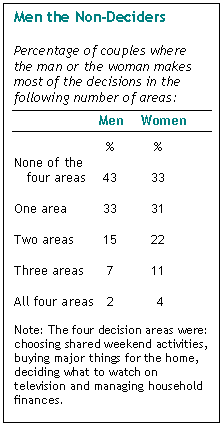
The questions about who calls the shots in different realms of domestic life were asked of 1,260 respondents who were married or living as a couple. For each question, respondents were asked if they or their partner generally has the final say in decision-making. They were not explicitly asked whether they generally share decisions – though this response was recorded if it was volunteered. And it proved to be a very common response. About half of all respondents said that they jointly decide or that there’s no fixed pattern when it comes to decisions about shared weekend activities and buying big things for the home. About four-in-ten said the same about deciding what to watch on television, and about one-in-three said the same about managing the household finances.3
Only one partner – the respondent – was interviewed; his or her answer was accepted as an accurate characterization of that couple’s decision-making. Responses were coded to indicate whether the man or the woman in the respondent’s couple makes most of the decisions, or whether the decisions are shared. For example, if a female respondent answered that she was mostly responsible for deciding on weekend plans, she was coded as being part of a couple in which the woman makes most of these decisions. If she said her partner mostly chooses what they would do, she was coded as being in a couple in which the man has the most say.
The responses to the four questions were then analyzed together to determine whether, on balance, the man or the woman in the respondent’s couple made the decisions in more areas, or whether both partners played an equal role.
Significantly, in a large plurality of couples – 43% – men don’t have the final say in any of the four areas tested. These men either share decision-making with their partners or defer to them. There are significantly fewer couples – 33% – in which the woman does not take the lead in any of the four areas tested. Also, more women (15%) than men (9%) are the lead decision-makers in three or more of the areas tested.
Generally, male and female survey respondents are in broad agreement about which gender makes most of the decisions in these realms of domestic life. The lone exception has to do with managing household finances. By a ratio of nearly two-to-one, women say that they (45%) rather than their partner (23%) manage the money in the household. Men see things differently. Some 37% say they manage the money, while just 30% report that their partner mostly handles the household finances.
The survey finds that when it comes to decision-making and consensus-building at home, age matters. Men and women 65 or older are twice as likely as those under the age of 30 to say they and their partner share equally in making family decisions. But while age makes a difference, income doesn’t – at least not so much. In dual-income couples, it is the woman who has more say, regardless of whether she earns more or less than her partner.
A total of 2,250 adults were interviewed by telephone for this nationally representative survey, including 1,260 who were married or living with a partner. Margin of sampling error for the results based on the subsample of those who were in couples is plus or minus 3 percentage points. Margin of sampling error for the overall results is plus or minus 2.3 percentage points.
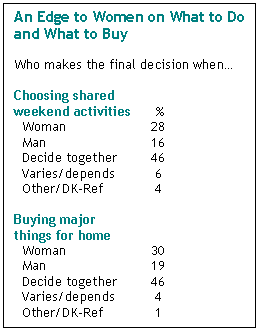
Here’s a rundown of the specific survey questions and responses:
Shared Weekend Activities
What are we doing this weekend, honey? For many couples, neither partner has the final word on shared weekend plans. Nearly half (46%) of all couples make this type of decision together, and in another 6% of couples, neither partner is the regular decision maker.
But among those couples in which one partner consistently takes the lead, it’s the woman and not the man who most often makes the call on weekend activities (28% vs. 16%).
Who Makes the Big Household Purchases?
A large plurality of couples (46%) jointly make decisions about buying major items for the home. But again, in families in which one person makes most of these decisions, it’s the woman and not the man who has the last word when purchasing big-ticket items for the home (30% vs. 19%).
The Battle of the Budget
While large proportions of couples make major home purchases and weekend plans together, other types of decisions are most often made by one partner. For example, fully two-thirds of all couples say one partner or the other mostly manages the household finances – but, in the agggregate, men and women disagree about which partner takes the lead.
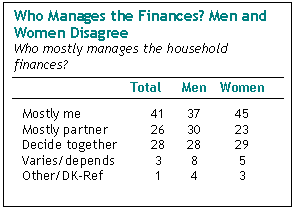
Overall, women are somewhat more likely than men to manage household finances (38% vs 30%). Fewer than three-in-ten couples (28%) equally share responsibility for making family financial decisions, the smallest percentage responding this way among the four areas tested.
However, comparing how men and women answer this question suggests that there is a good bit of gender disagreement over who ultimately controls the family’s purse strings. By nearly 2-1, women say they and not their husbands control the family pursestrings (45% vs. 23%). But a narrow plurality of men say they, not their wives, are managing the fa mily finances (37% vs. 30%).
On the other three questions, the sexes largely agree who has the ultimate say. By about 2-1, women say they and not their partner decide how the couple will spend weekend time together (30% vs.14%) and decide on major home purchases (33% vs. 17%). In both cases, but by narrower margins, men agree their wives or partners usually make these decisions.
Who Controls the TV Remote?
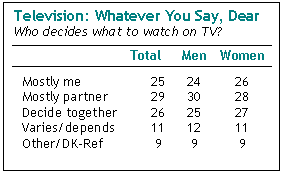
While husbands and wives may differ over who controls the family checkbook, there’s not much dispute over who controls the television remote control. The consensus from all quarters: not me. About a quarter of all husbands and wives say they make decisions together and another one-in-nine say there’s no consistent pattern to the spousal decisions on this front. Women say they are about as likely to decide what to watch on television (26%) as their spouses (28%). Men are slightly more likely to say their spouse decides (30%) than say they control the remote (24%).
Factoring the respondent’s gender into the analysis produces a similar overall result. In 27% of all couples, it’s the woman who decides what to watch on TV. The man decides in 26% of couples, and in about a quarter of all homes, what to watch is decided together.
One complicating factor: Perhaps there’s relative peace in front of the TV because husbands and wives are simply watching different televisions, or watching their favorite shows alone at different times.
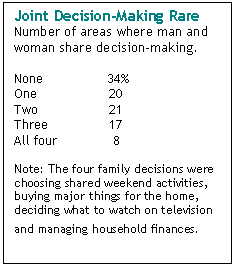
Nielsen Media Research reported in 2006 that there were more televisions than people in the average American home. This survey did not ask how many working televisions respondents had in their homes, or whether couples generally watched TV together or at different times, leaving open the possibility that when it comes to controlling the remote, “separate but equal” may help keep the peace in some American homes.
Many couples make some family decisions together but very few make all decisions together. When it comes to deciding on shared weekend activities, nearly half (46%) of men and women say they make the decision jointly with their spouses. But in other areas, shared decision-making is relatively rare. For example, only 28% of all couples say they share responsibility for managing household finances.
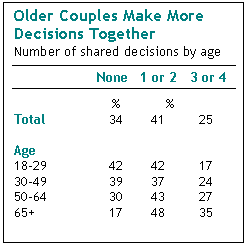
Overall, only 8% of couples say they make the decisions together in each of the four areas tested in the poll. Another 17% say they make joint decisions in three of the four. Conversely, a 54% majority say they make joint decisions in just one (20%) or none (34%) of the aspects of family life.
It is possible that the share of “we decide together” responses would have been greater if this option was explicitly presented in the question. It was not. Rather, the question was worded to ask whether the respondent or his/her partner generally made decisions. In order for a respondent to be recorded as saying decisions are shared, that respondent had to volunteer this answer.
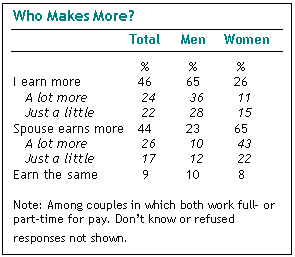
With one notable exception, patterns of decision-making by couples vary little among most demographic groups. The exception has to do with age: Older couples are significantly more likely than younger couples to make decisions together, the survey finds. More than a third of all adults 65 or older say they make most of the decisions with their spouses in at least three of the four areas tested – double the proportion of the joint decision-makers among couples younger than 30. Conversely, fully four-in-ten young adults who are married or living together say they do not make decisions together, with the majority saying they make most of the decisions themselves.
Money and Power in the Home
Two-thirds of all husbands in dual-income families say they make more money than their wives, and wives generally concur in this assessment. But earning more money doesn’t necessarily mean making more decisions at home, at least for men. And for women, earning less doesn’t always mean making fewer decisions.
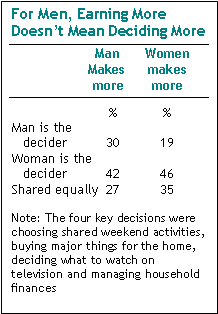
By a ratio of better than two-to-one, women make most of the household decisions (46% vs. 19%) in couples in which the woman earns more than the man. Among couples in which the man earns more than his female partner, women still are more likely to make the decisions in more areas, but by a narrower margin (42% vs. 30%).
Gender Roles in Positions of Authority
While many Americans say it makes no difference to them whether they deal with a man or woman in a range of high-profile positions of authority, the survey finds that they retain strong traditional gender preferences in a few positions, including elementary school teacher and police officer. The other positions tested were banker, surgeon, lawyer, airline pilot and family doctor. Here is a rundown of the public’s responses, based on interviews with the full sample of 2,250 adults.
Traditional roles
Most of the nation’s elementary school teachers are female, most police officers are male, and Americans generally prefer it that way. This attitude is especially prevalent when it comes to elementary school teachers; majorities of both genders and all race and age groups say they would rather deal with a woman than a man in that role.
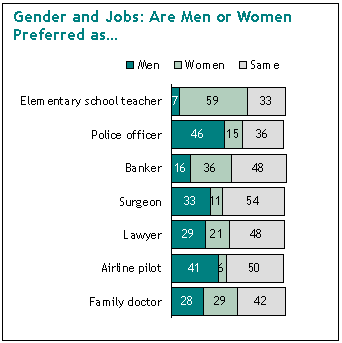
Among Americans of different education levels, college graduates are the only group in which there is not a majority preference for female teachers; they split their opinions evenly between female and no preference.
Asked about the preferred gender for police officer, Americans give a plurality of votes- 46%- to males. Although men are slightly more likely than women to prefer female teachers, there is no difference between the genders in their preference for policemen.
But Americans 65 years old or older are more inclined than younger adults to prefer a male policeman – 55% do, which is at least eight percentage points more than is the case with any younger age group.
Although no demographic group prefers a female police officer, one in four black or Hispanic Americans say they would rather deal with a policewoman, compared with 12% of whites.
Surgeons and airline pilots are traditionally male occupations that remain heavily male, but half or more of Americans say it makes no difference to them whether a man or woman holds those jobs.
Majorities of men (57%) and women (52%) say they have no preference for a male or female surgeon. A third of men (32%) and women (34%) say they prefer a man, and the rest prefer a woman. Older people are most likely to prefer a male surgeon. Blacks, and to a lesser extent Hispanics, are more likely than whites to prefer a male surgeon.
When it comes to airline pilots, men (53%) are somewhat more likely than women (47%) to say they have no preference. Men (38%) are less likely than women (44%) to prefer a male pilot. Hispanics (53%) and blacks (49%) are more likely than whites (38%) to prefer that their pilot be male. Older Americans also are more likely to prefer a male pilot, women more so than men.
Family doctor
Gender differences play a role in preferences for a male or female family doctor, a traditionally male field that has been attracting growing numbers of females. Men are most likely to express no preference (46%), but a notable share prefers a male doctor (35%). Women split their votes between no preference (38%) and a female doctor (39%).
Age also plays a role: Older Americans are more likely to prefer a man, while younger ones are more likely to prefer a woman.
Banker and Lawyer
The financial services and legal professions also are traditionally male, but increasingly populated by women. About half of Americans (48%) say they have no preference between a male or female banker or lawyer. This is especially true of whites, college-educated Americans and high-income respondents. People who live in the West also are most likely than Americans in other regions to have no preference for a male or female banker or lawyer.
After “no preference,” though, Americans’ second choice for their banker would be a woman (36%), which is true for both male and female respondents. Younger people are more evenly split between expressing no preference and favoring a woman. Older people are somewhat more likely to prefer a man to a woman.
Some groups are more likely to prefer a woman to a man or to the no-preference option. They include blacks and Hispanics (47% of each favors a woman banker), as well as Americans who have not graduated high school or who are in the lowest income group. Notably, even Americans who say they believe women should return to their traditional roles say they prefer a woman (37%) to a man (23%) for their banker.
As for their lawyer, men (51%) are slightly more likely than women (46%) to express no preference. Men (28%) and women (30%) are about equally likely to prefer a male lawyer. Women (23%) are somewhat more likely than men (18%) to prefer a female lawyer.
There are racial differences in lawyer preference. Most whites (54%) say gender doesn’t matter. Hispanics and blacks are more likely than whites to split their votes among men, women or no preference. A narrow majority of middle-aged Americans (30-49 and 50-64) say they have no preference, compared with four-in-ten of younger or older Americans. Younger and older Americans cast more of their votes for male lawyers than do middle-aged Americans.
Sub-Group Preferences
In general, older Americans are most likely to prefer men in traditionally male jobs. Blacks and Hispanics are more likely than whites to favor men in some traditionally male jobs, but tilt toward women in others. College graduates are more likely than less-educated Americans to express no job preference for either gender.
There’s very little difference between male and female survey respondents over which gender they would rather deal with in each profession tested. The lone exception to this pattern is the family doctor. Here, gender solidarity prevails. Female respondents express a preference for a woman doctor by a ratio of nearly two-to-one, while male respondents say they would prefer to deal with a male family doctor by a ratio of about two-to-one.




